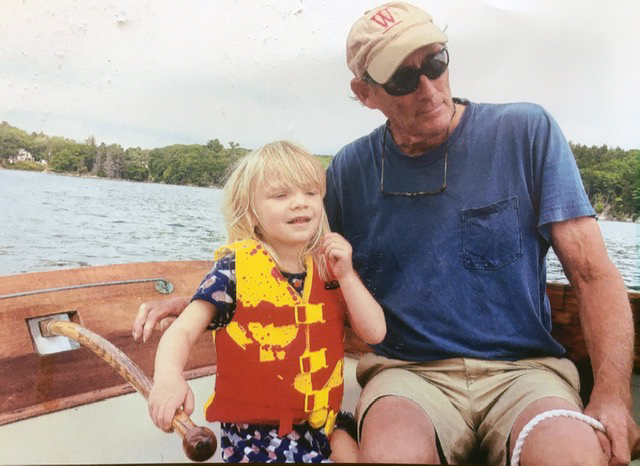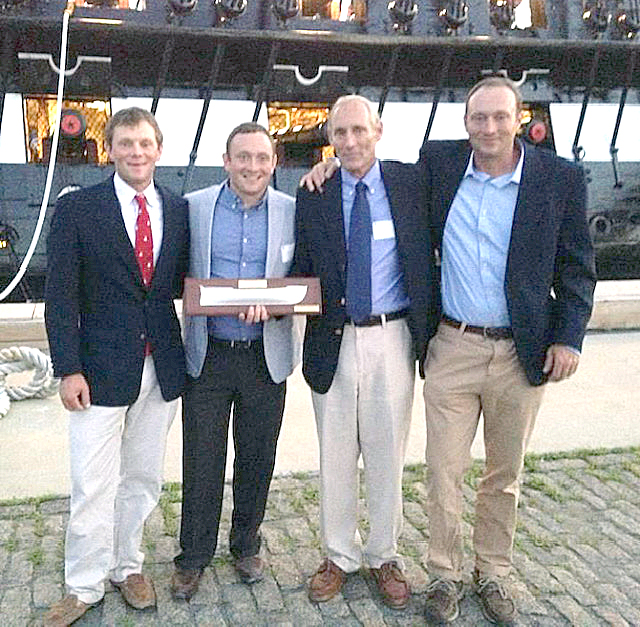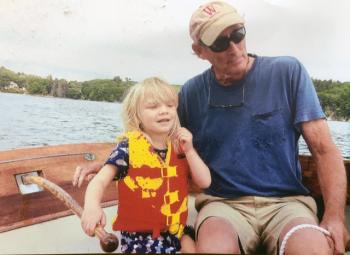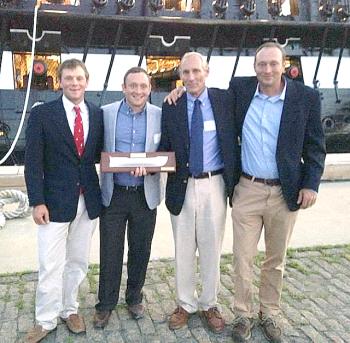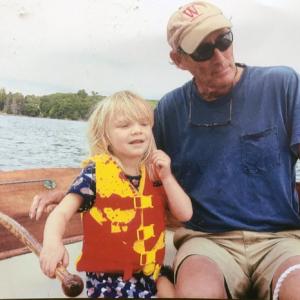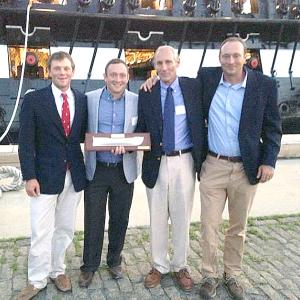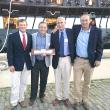Maritime Explorers: Nat Wilson and his three sons
The 61st annual Windjammer Days will take place Sunday, June 25 through Saturday, July 1, 2023. This year the Friends of Windjammer Days is celebrating our rich population of Maritime Explorers. Those featured have traveled extensively on different bodies of waters either for work, pleasure or both.
One of Nat Wilson’s earliest memories was summering on Fisherman Island and learning to row in a dory with his brother Gregg, sister Janet, father Jack and his uncle Jim. As they grew stronger, they would make trips to all the other outer islands in a fleet of two dories and skiff Beloved. In the summer of 1967 Nat Wilson was making the daily commute to the Ocean Point Inn to work, rowing to and from Fisherman Island each way. By the summer of 1969 Nat was working for Eliot Winslow on the Argo as a deck hand. That summer he received his draft notice. Upon hearing this Eliot said,“take the day off and drive to the Portland Coast Guard recruiter and sign up.” There were two openings left for October and Nat signed up on the spot.
After boot camp Nat was assigned to the Public Information Office in Cape May, New Jersey where he did layout for Coast Guard publications and assisted the base photographer. The Coast Guard had a sailing team in Cape May and its fleet consisted of three Thistle Class Sloops. Nat was given one to use and race at the Cape May Corinthian Yacht Club on the weekends. The Cape May Coast Guard sailing team was invited to represent the Fourth Naval District in a Navy wide regatta at Annapolis Naval Academy. Using Naval Academy sailboats they sailed in three races per day and the competition ran for several days. They earned a third-place finish in that regatta.
Nat then transferred to New London, Connecticut and was stationed on the USCG Barque Eagle in early spring of 1971 and that was when his sail-making training began. When in port Nat reported to the academy sail loft to learn sail-making skills and to repair sails from the academy fleet. In 1972 the Eagle began her spring cruise to the Gulf Coast making visits to Galveston, Texas, New Orleans, Louisiana and Mobile, Alabama. While underway the captain received orders to return to New London to prepare for a transatlantic passage to the Isle of Wight, United Kingdom. They were to participate in the Sail Training Race with other sail training vessels. The Eagle had also been chosen to take part in Olympic Events in Kiel, Germany. It took 16 days to sail from New London to the Island of Wight, tying up at the Portsmouth Naval Yard Spit Head. The race started in the Solent River east of the Isle of Wight with two other Class A vessels, Bark Gorch Fock II and the Polish Training Ship Dar Pomorza. The course was mostly in the North Sea to the Northern tip of Denmark at the Skagens Rev Light Vessel, a 645-mile race to the windward. It was a challenging race for both vessels and crew. The Eagle finished third and within six hours of the winner, Dar Pomorza. A full account of the race was published in the Proceedings of the Naval Institute in February of 1974. The three training vessels traveled in tandem to Malmo, Sweden. Here they joined the fleet of vessels that raced from Helsinki, Finland. Sail training vessels flags participating were British, Dutch, French, German Polish and Swedish.
After Sweden, the Eagle sailed to the ancient walled port of Lubeck, Germany which was her homeport when she was the German Training Vessel Horst Wessel. They received a moving reception there. They were open daily to the public with visitors of former crew expressing their emotions outwardly to be onboard their old ship. Some wanted to see the engine room as their main engine was the original MAN diesel, the same engine used in German U Boats. From Lubeck they then traveled down the Trave River which was the dividing line between East and West Germany. To the east was a no man’s land and to the west was the resort port of Travamunde.
The Eagle was heading to the Bay of Kiel to join six other square rigged sailing vessels plus schooners and a fleet of some estimated 2,000 spectator vessels. The waterfront was in festival mode with beer tents, brass bands and all sorts of food as Kiel was hosting Olympic sailing and other water events. The festivities all came to a halt overnight when the violent terrorist attacks associated with the Munich Massacre occurred. Captain Cassidy addressed the crew and told them that they were departing soon and were not allowed ashore. The Academy Cadets were flown back to New London. Additional crew was added to the ranks of the Eagle, including two college age crews and several Navy sub mariners to round out the deck and engine room watches for the passage home. The Eagle then experienced the best sailing, driven by strong trade winds. They had stops in Lisbon and the island of Madeira in Portugal. Between Madeira and home, they encountered 12 hours of tropical storm conditions before arriving back in New London.
Nat’s next transatlantic passage began in August 1974 when he took a leave of absence from his job at Mystic Seaport to take a mate’s job on the 103-foot schooner Puritan for her passage to Palma, Mallorca. Along the way they visited Bermuda, traveled onto Horta in the Azores and the Strait of Gibraltar. This was the start of a 20-year relationship with the Puritan under three captains and two owners, both making her sails and helping crew racing in Costa Smeralda, Sardinia, Imperia, Italy and Saint Tropez. Puritan became one of the first Large Classic Yachts to race in the regattas in the Mediterranean. Another compelling adventure during this time involved being part of the crew of the Sheila Yeates when she became icebound off the coast of Greenland in the summer of 1989. For a full account, pictures and video footage go to https://americanlandscapegallery.com/1-3-4-ice-bound.
A former Puritan captain called Nat in March 1997 and said he had taken over the refit of the schooner yacht Mariette which was built in 1915-1916 by Nathaniel Herreshoff. After refit she was to enter the Atlantic Challenge Race from Sandy Hook to the Lizard Light in Cornwall, England. Nat was responsible for maintaining the sails and also to stand a watch. Ted Smith from Southport also sailed in this race, but on the William Fife ketch Sumurun. The Mariette also has a Boothbay Harbor connection as during World War II she served as a submarine patrol vessel and after the war she was laid up at Frank L. Sample’s Shipyard. Soon after she had a new owner with a new name of Gee Gee II with Captain Fuller Dunton of Boothbay Harbor as the sailing master. Sample’s Shipyard installed a new 130-foot hollow Marconi main mast and changed her rig into a staysail schooner.
Sailmaking remained a mainstay while Nat was on land in his Sail Loft in East Boothbay. He is most proud of the work that his loft did on making the sails for Old Ironsides. He was given the opportunity to sail on her three times. Another milestone achievement was working in partnership with North Cloth, which was the fabric division of North Sails. He and North Cloth developed a sailcloth named Oceanus which was designed for heavy displacement sailing vessels. It has proven to be a durable sailcloth with good sail shape retention and is now in its 28th year of production. Nat is proud to share a select list of the large sailing vessels that set sails built in his sail loft over the last 50 years in his loft: Iron Bark Elissa, Galveston, Texas, Barkentine Gazela of PHILADELPHIA, Schooner Lewis R. French, Topsail Schooner Shenandoah, Topsail Schooner Pride of Baltimore, Schooner American Eagle, Ship Mayflower II, Schooner Lady Maryland, Schooner Lettie G Howard, Schooner Victory Chimes, Schooner Harvey Gamage, Hudson River Sloop Clearwater, Whaling Ship Charles W. Morgan, USCG Bark Eagle, Gloucester Schooner Adventure, Schooner Yacht Puritan, Schooner Yacht Adventuress, Fife Ketch Bella Venture, NY-50 Spartan.
The Wilson Family’s maritime tradition has continued on with son Nat who was born in Boothbay Harbor in 1977 and at the early age of 6 months sailed with his parents to Barbuda from Antigua. This was a prelude of things to come. Growing up he sailed along the Maine coast and upon graduation from the Boothbay Region High School he took his first professional sailing job on the Tall Ship Rose as a deckhand. The Rose was located in Hawksnest Bay, St. John which enabled Nat Jr. to spend the winter sailing the Caribbean and then eventually returning to Bridgeport, Connecticut via Key West. That next summer he got his Maine Guide license for sea kayaking tours and ended up working at Tidal Transit near the Chowder House in downtown Boothbay Harbor. The following winter Nat jumped a one way flight to Fort Lauderdale looking for yacht work. Two weeks later he ended up in Venezuela, then sailed to Trinidad where he spent the winter before sailing back to Florida and returning to Maine in his newly bought Toyota truck. He worked between Maine and the islands for many years.
In 2005 Nat flew to Australia where he joined the schooner Adix in Sydney Harbor. He spent a few weeks there before departing for the Roaring Forties (the strong westerly winds in the Southern Hemisphere) and New Zealand. He spent six months in New Zealand before sailing to Bora Bora, Mora and then onto the Pitcairn Islands and the Galapagos. The voyage continued through the Panama Canal and commenced at Newport, Rhode Island.
After spending the summer cruising the Northeast, Nat Jr. then departed to Europe where he spent two years on classic sailing yachts before sailing to the Caribbean on the yacht Eleonora. From there he captained yachts including the 88-foot ketch Sincerity and the ketch Ticonderoga between the Caribbean and the Northeast on a regular basis. In 2016 Nat moved to Charleston, South Carolina and started a marine service company which repairs yachts. He continues to sail and explore new places via motorcycle with his travels taking him across the USA and most recently to Labrador.
Brother Eben Wilson was drawn to the water at an early age too as he says that with parents like his they were on the water from week one. By age 5 he was easily rowing small boats around. One summer at a small craft meet at the Maine Maritime Museum a man named Plat Monford saw Eben rowing the Whitehall around and thought he should design and build a lightweight skin on frame one for easier use. That led to the design called the Ebenezer Wilson which can still be bought on the WoodenBoat website. At age 8 Eben got his first lobster license and acquired his great-grandfather’s 1932 dory for a handshake. He fished with her for a few years rowing to his traps until he got a flat bottomed skiff with a 2.5 horsepower outboard. Over the next years Eben had several different boats for lobstering, gradually getting bigger until he bought a 32-foot Jonesporter when he was just out of high school. Sailing was always mixed into their adventures throughout the years as well as working in the Sail Loft with their father in the winter.
By his early 20s Eben was ready for a change and in December of 2007 he took all his lobster gear and boat to the Caribbean to get jobs on yachts. With his sail-making experience he landed a job working in the repair loft in English Harbor, Antigua. His brother Nat was also in the Caribbean at the same time working on the classic schooner Eleonora. That winter Eben was able to sail in five Caribbean regattas and then got a position for the race and delivery crew on the William Fife schooner Altair. The Altair and crew left Antigua in early May of 2008 and sailing to Scotland via Horta, Azores. That June they sailed in the William Fife regatta in the River Clyde. This and other experiences catapulted Eben into the classic yacht scene in the US and Europe. Eben has been back home since 2011 and has returned to lobstering full time, but he still races often and is connected with many programs and boats, most notably the Herreshoff New York 50 Spartan. He has been the Spartan’s primary rigger and sailmaker working along with his father Nat for 13 years. The Spartan is based in Palma, Mallorca. Eben and his wife now own their own classic yacht Zephyr which was built in East Boothbay at the P.E. Luke yard in 1961. It is a varnished hull Sparkman & Stephens Gulfstream 36. They take their girls sailing up and down the Maine coast throughout the summer.
Nat’s youngest son Nick spent a number of summers in high school and college on the sea working first as an apprentice on the Schooner Lewis R. French, and then as crew on the Schooners Shenandoah and American Eagle. After moving to San Francisco, he bought a classic 1940s Bear Boat and sailed all over San Francisco Bay with his soon to be wife Robin. He has continued to love sailing the family Herreshoff sloop when back in Maine.
Nat Sr. has now owned his boat Tarpon for 48 years come this June. Sailing in local waters with his wife Rhonda has given him the most enjoyment and he reports always making it home on a favorable tide. He hopes that his grandchildren will continue the sailing tradition as they grow.

